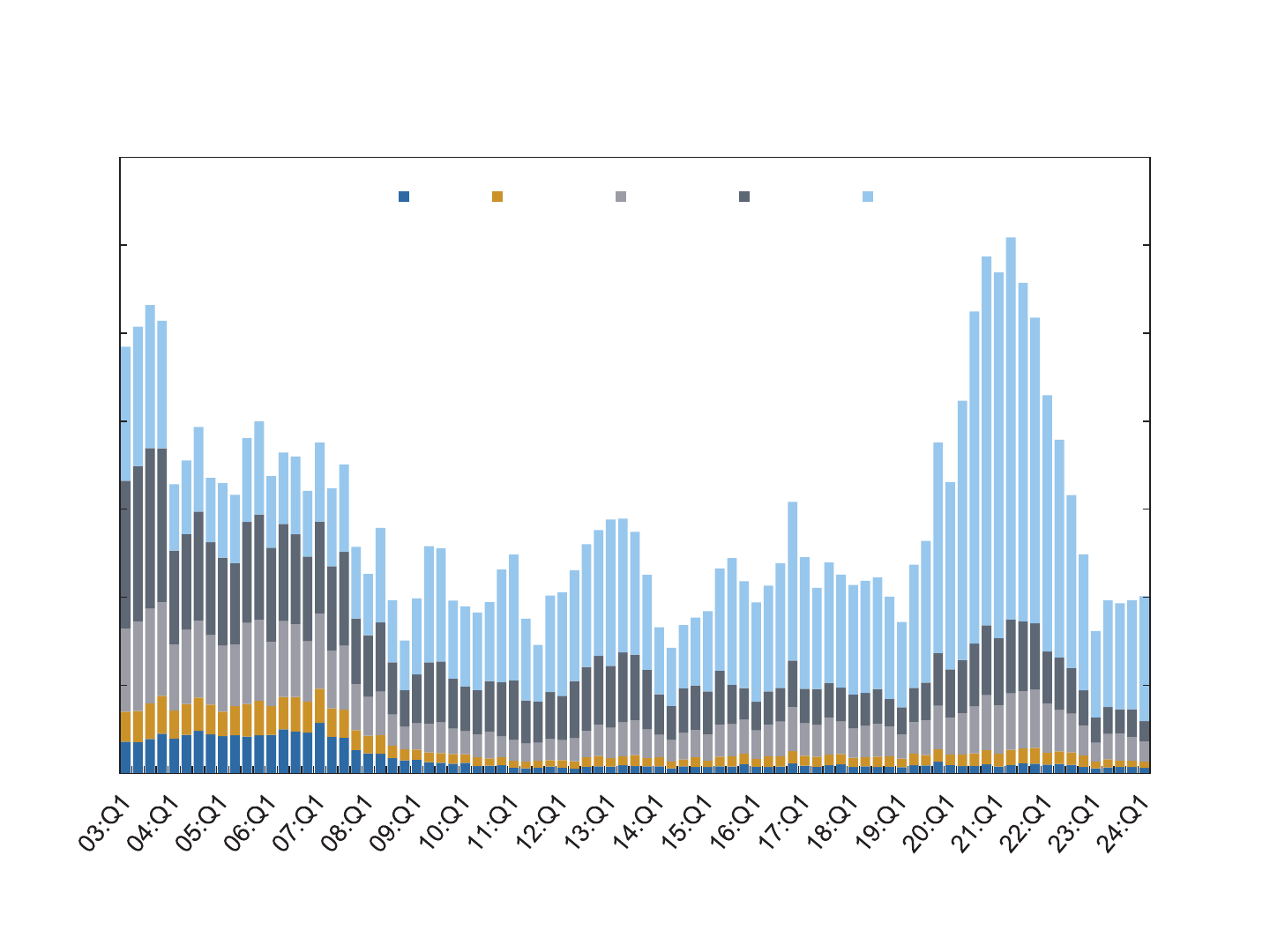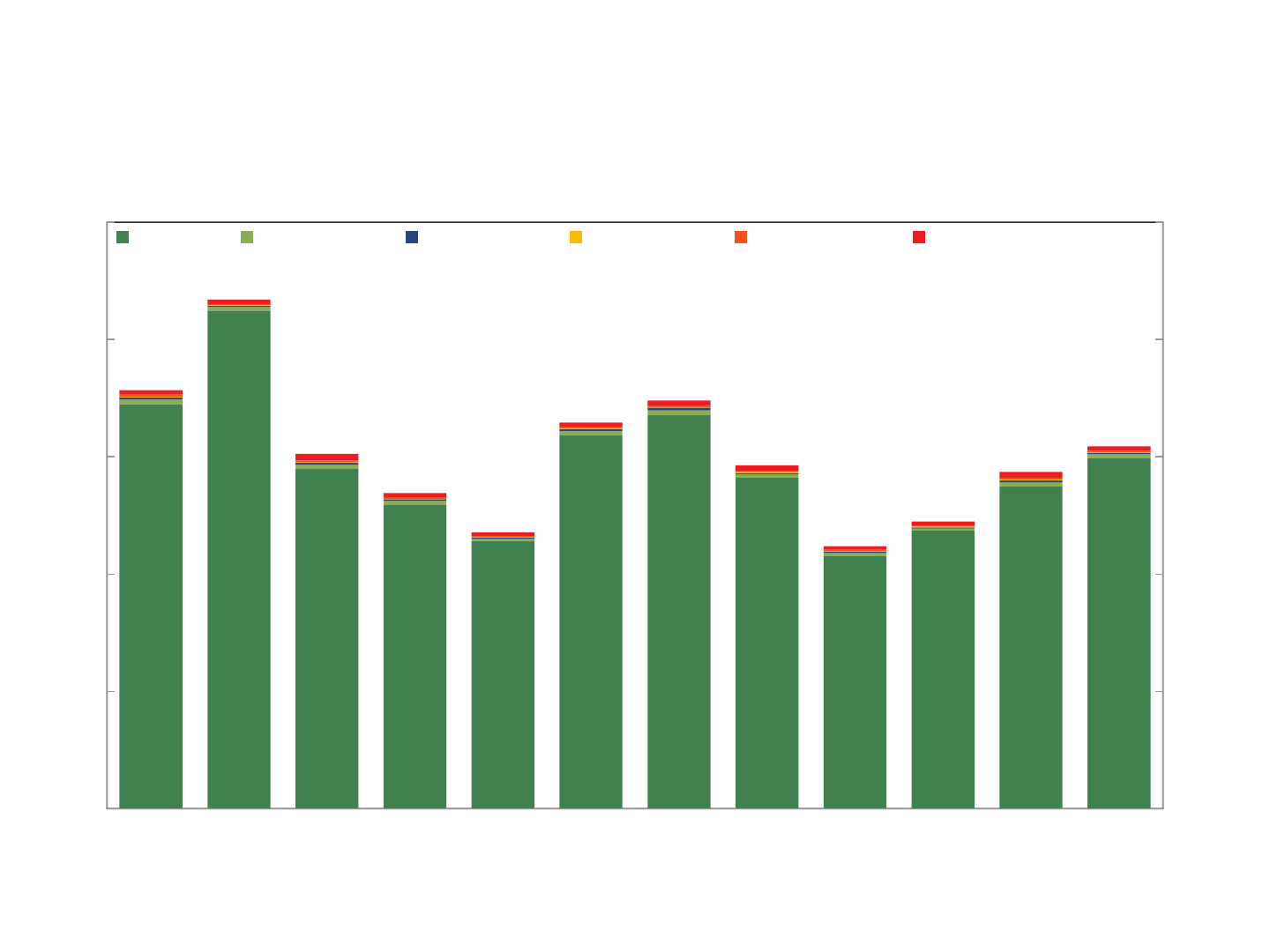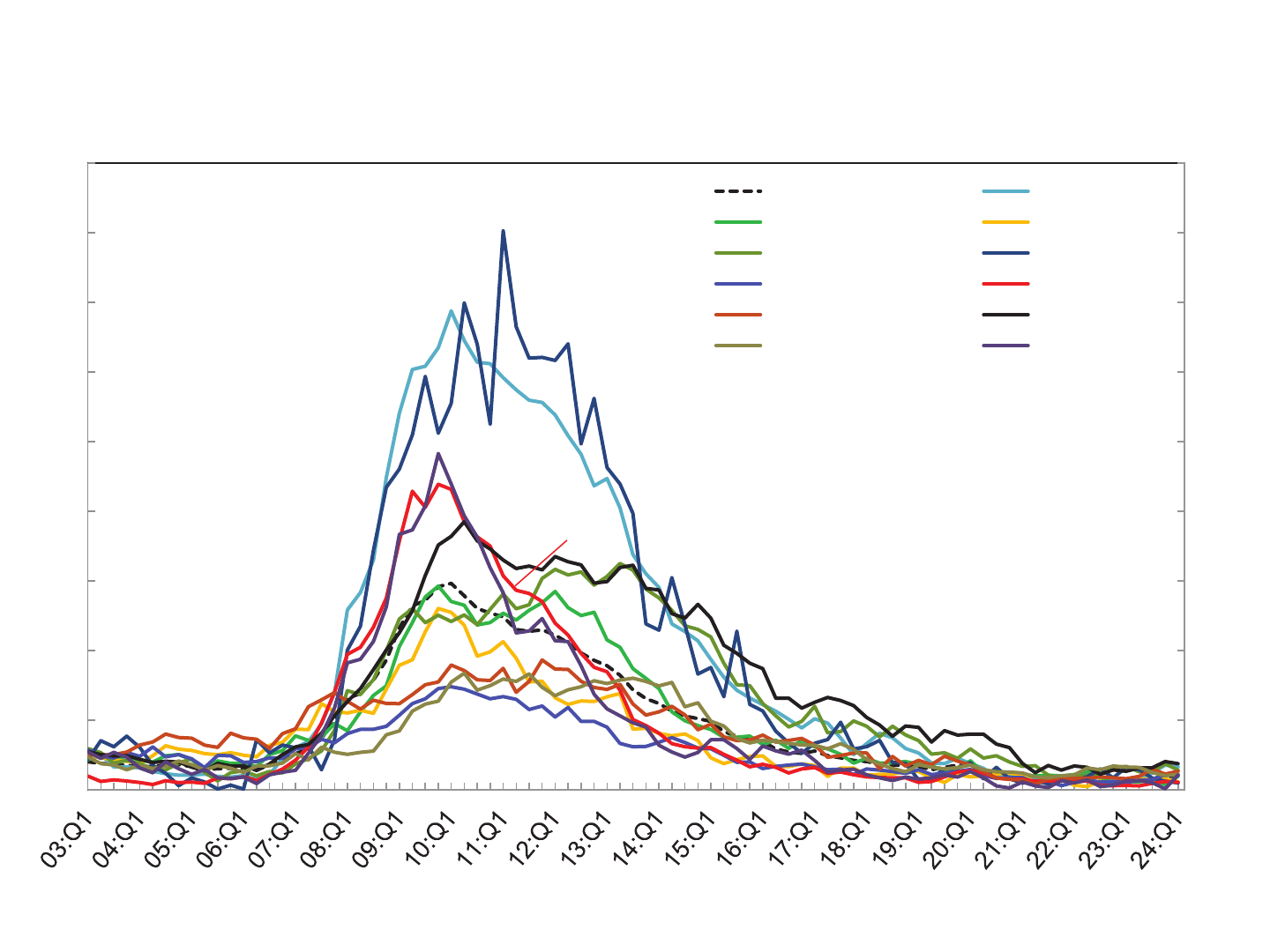
ANALYSIS BASED ON NEW YORK FED CONSUMER CREDIT PANEL/EQUIFAX DATA
QUARTERLY REPORT ON
HOUSEHOLD
DEBT AND CREDIT
2024:Q1 (RELEASED MAY 2024)
FEDERAL RESERVE BANK of NEW YORK
RESEARCH AND STATISTICS GROUP
CENTER FOR MICROECONOMIC DATA
WWW.NEWYORKFED.ORG/MICROECONOMICS

Household Debt and Credit Developments in 2024Q1
1
Aggregate household debt balances increased by $184 billion in the first quarter of 2024, a 1.1% rise from 2023Q4. Balances
now stand at $17.69 trillion and have increased by $3.5 trillion since the end of 2019, just before the pandemic recession.
Balances
Mortgage balances shown on consumer credit reports increased by $190 billion during the first quarter of 2024 and stood at
$12.44 trillion at the end of March. Balances on home equity lines of credit (HELOC) increased by $16 billion, the eighth consecutive
quarterly increase after 2022Q1, and there is now $376 billion in aggregate outstanding balances, $59 billion above the series low
reached in the third quarter of 2021. Credit card balances, which are now at $1.12 trillion outstanding, decreased by $14 billion during
the first quarter but remain 13.1% above the level a year ago. Auto loan balances increased by $9 billion, continuing the upward
trajectory that has been in place since 2020Q2, and now stand at $1.62 trillion. Other balances, which include retail cards and other
consumer loans, decreased by $11 billion. Student loan balances were effectively flat, with a $6 billion decrease, and stand at $1.6
trillion. In total, non-housing balances fell by $22 billion.
Originations
Mortgage originations, measured as appearances of new mortgages on consumer credit reports and including both refinance
and purchase originations, continued at the same pace observed in the previous three quarters, at $403 billion in 2024Q1, and well
below the trillion-dollar-plus quarterly origination volumes observed between 2020Q2 and 2021Q4. Aggregate limits on credit cards
increased modestly, by $63 billion (1.3%) in the first quarter, after eleven consecutive quarters of meaningful increases. Limits on
home equity lines of credit (HELOC) grew by $30 billion, and have grown by 14% over the past two years after ten years of
decreases.
Credit quality of newly originated loans was steady, with 3% of mortgages and 16% of auto loans originated to borrowers
with credit scores under 620, roughly unchanged from the fourth quarter. The median credit score for newly originated mortgages was
flat at 770, while the median credit score of newly originated auto loans was four points higher than last quarter at 724, the highest on
record.
Delinquency & Public Records
Aggregate delinquency rates increased in the first quarter of 2024. As of March, 3.2% of outstanding debt was in some stage
of delinquency, up by 0.1 percentage point from the fourth quarter. Still, overall delinquency rates remain 1.5 percentage points lower
than the fourth quarter of 2019.
Delinquency transition rates increased for all product types. Over the last year, approximately 8.9% of credit card balances
and 7.9% of auto loan balances transitioned into delinquency. Early delinquency transition rates for mortgages increased by 0.3
percentage point yet remain low by historic standards.
About 121,000 consumers had a bankruptcy notation added to their credit reports in 2024Q1, more than in the previous
quarter. Approximately 4.8% of consumers have a 3rd party collection account on their credit report.
Housing Debt
There was $403 billion in newly originated mortgage debt in 2024Q1.
About 44,000 individuals had new foreclosure notations on their credit reports, slightly more than the previous quarter. New
foreclosures have stayed low since the CARES Act moratorium was lifted.
Student Loans
Outstanding student loan debt was roughly unchanged and stood at $1.60 trillion in 2024Q1.
Missed federal student loan payments will not be reported to credit bureaus until 2024Q4. Because of these policies, less than 1%
of aggregate student debt was reported 90+ days delinquent or in default in 2024Q1 and will remain low until at least 2024Q4.
1
This report is based on the New York Fed Consumer Credit Panel, an anonymized, nationally representative sample drawn from Equifax credit report data. For more
details, see the data dictionary at the end of this report. Contact Joelle Scally with questions at [email protected].

May 2024
FEDERAL RESERVE BANK OF NEW YORK
RESEARCH AND STATISTICS ● MICROECONOMIC STUDIES
Table of Contents
NATIONAL CHARTS
Total Debt Balance and its Composition..................................................................................3
Number of Accounts by Loan Type.........................................................................................4
Total Number of New and Closed Accounts and Inquiries......................................................5
Mortgage Originations by Credit Score....................................................................................6
Credit Score at Origination: Mortgages....................................................................................7
Auto Loan Originations by Credit Score..................................................................................8
Credit Score at Origination: Auto Loans..................................................................................9
Credit Limit and Balance for Credit Cards and HE Revolving .............................................10
Total Balance by Delinquency Status.....................................................................................11
Percent of Balance 90+ Days Delinquent by Loan Type.......................................................12
Flow into Early Delinquency (30+) by Loan Type................................................................13
Flow into Serious Delinquency (90+) by Loan Type.............................................................14
Quarterly Transition Rates for Current Mortgage Accounts .................................................15
Quarterly Transition Rates for 30-60 Day Late Mortgage Accounts ....................................16
Number of Consumers with New Foreclosures and Bankruptcies ........................................17
Third Party Collections...........................................................................................................18
SELECT CHARTS BY AGE
Total Debt Balance By Age....................................................................................................20
Debt Share by Product Type and Age (2024Q1)....................................................................21
Auto Loan Originations by Age.............................................................................................22
Mortgage Originations by Age...............................................................................................23
Quarterly Transition into Serious Delinquency (90+) by Age...............................................24
Quarterly Transition into Serious Delinquency (90+) for Mortgages by Age.......................25
Quarterly Transition into Serious Delinquency (90+) for Auto Loans by Age.....................26
Quarterly Transition into Serious Delinquency (90+) for Credit Cards by Age....................27
Quarterly Transition into Serious Delinquency (90+) for Student Loans by Age.................28
New Foreclosures by Age......................................................................................................29
New Bankruptcies by Age.....................................................................................................30
CHARTS BY SELECT STATE
Total Debt Balance Per Capita by State.................................................................................32
Composition of Debt Balance per Capita* by State (2024Q1) .............................................33
Delinquency Status of Debt Balance per Capita* by State (2024Q1) ..................................34
Percent of Balance 90+ Days Late by State...........................................................................35
Percent of Mortgage Debt 90+ Days Late by State ...............................................................36
Quarterly Transition Rates into 30+ Days Late by State........................................................37
Quarterly Transition Rates into 90+ Days Late by State .......................................................38
Percent of Consumers with New Foreclosures by State ........................................................39
Percent of Consumers with New Bankruptcies by State ........................................................40

Page Left Blank Intentionally
1

NATIONAL CHARTS
2

0
3
6
9
12
15
18
Mortgage HE Revolving Auto Loan Credit Card Student Loan Other
Trillions of Dollars
Total Debt Balance and its Composition
Source: New York Fed Consumer Credit Panel/Equifax
2023Q4 Total: $17.50 Trillion
(3%)
(9%)
(6%)
(9%)
(2%)
(70%)
2024Q1 Total: $17.69 Trillion
3

4
0
100
200
300
400
500
600
0
50
100
150
200
250
Number of Accounts by Loan Type
Millions
Millions
Credit Card
(Right Axis)
Mortgage
(Left Axis)
Auto Loan
(Left Axis)
HE Revolving
(Left Axis)
Source: New York Fed Consumer Credit Panel/Equifax

5
0
50
100
150
200
250
300
350
400
0
50
100
150
200
250
300
350
400
Total Number of New and Closed Accounts and
Inquiries
Millions
Millions
Number of Inquiries within 6 Months
Number of Accounts Opened within 12 Months
Number of Accounts Closed within 12 Months
Source: New York Fed Consumer Credit Panel/Equifax

6
0
200
400
600
800
1,000
1,200
1,400
0
200
400
600
800
1,000
1,200
1,400
<620 620-659 660-719 720-759 760+
Source: New York Fed Consumer Credit Panel/Equifax
* Credit Score is E
q
uifax Riskscore 3.0
Mortgage Originations by Credit Score*
Billions of Dollars
Billions of Dollars

7
500
550
600
650
700
750
800
500
550
600
650
700
750
800
Credit Score at Origination: Mortgages*
Score Score
Source: New York Fed Consumer Credit Panel/Equifax
* Credit Score is E
q
uifax Riskscore 3.0
;
mort
g
a
g
es include first-liens onl
y
.
50th percentile
25th percentile
10th percentile

8
0
40
80
120
160
200
0
40
80
120
160
200
<620 620-659 660-719 720-759 760+
Source: New York Fed Consumer Credit Panel/Equifax
* Credit Score is Equifax Riskscore 3.0
Auto Loan Originations by Credit Score*
Billions of Dollars
Billions of Dollars

9
500
550
600
650
700
750
800
500
550
600
650
700
750
800
Credit Score at Origination: Auto Loans*
Score
Source: New York Fed Consumer Credit Panel/Equifax
* Credit Score is Equifax Riskscore 3.0
50th percentile
25th percentile
10th percentile
Score

10
0
1
2
3
4
5
0
1
2
3
4
5
HELOC Balance CC Balance CC Limit HELOC Limit
Trillions of Dollars Trillions of Dollars
Credit Limit and Balance for Credit Cards and HE
Revolving
Source: New York Fed Consumer Credit Panel/Equifax

11
0
2
4
6
8
10
12
14
0
2
4
6
8
10
12
14
Severely Derogatory 120+ days late 90 days late 60 days late 30 days late Zero
Total Balance by Delinquency Status
Percent
Source: New York Fed Consumer Credit Panel/Equifax
Percent

12
0
5
10
15
0
5
10
15
Credit
Card
Mortgage
Auto Loan
HE Revolving
Percent of Balance 90+ Days Delinquent
by Loan Type
Percent
Percent
Source: New York Fed Consumer Credit Panel/Equifax
Student Loan

13
0
2
4
6
8
10
12
14
16
0
2
4
6
8
10
12
14
16
Transition into Delinquency (30+) by Loan Type
Source: New York Fed Consumer Credit Panel/Equifax
Note: 4 Quarter Moving Sum
Student loan data are not reported prior to 2004 due to uneven reporting
Credit Card
Mortgage
Auto Loan
HE Revolving
Percent of Balance
Student Loan
Percent of Balance

14
0
2
4
6
8
10
12
0
2
4
6
8
10
12
Student Loan
Transition into Serious Delinquency (90+)
by Loan Type
Source: New York Fed Consumer Credit Panel/Equifax
Note: 4 Quarter Moving Sum
Student loan data are not reported prior to 2004 due to uneven reporting
Credit Card
Mortgage
Auto Loan
HE Revolving
Percent of Balance
Percent of Balance

15
0.0
0.5
1.0
1.5
2.0
2.5
3.0
3.5
0.0
0.5
1.0
1.5
2.0
2.5
3.0
3.5
To 30-60 days late
To 90+ days late
Quarterly Transition Rates for Current Mortgage
Accounts
Percent Percent
Source: New York Fed Consumer Credit Panel/Equifax

0
10
20
30
40
50
60
70
0
10
20
30
40
50
60
70
To Current
To 90+ days late
Quarterly Transition Rates for 30-60 Day Late
Mortgage Accounts
Percent Percent
Source: New York Fed Consumer Credit Panel/Equifax
16

17
0
300
600
900
1,200
0
300
600
900
1,200
Foreclosures Bankruptcies
Thousands
Number of Consumers with New Foreclosures
and Bankruptcies
Thousands
Source: New York Fed Consumer Credit Panel/Equifax

18
800
900
1,000
1,100
1,200
1,300
1,400
1,500
1,600
1,700
4
6
8
10
12
14
16
Third Party Collections
Dollars
Percent of consumers
with collection
(Left Axis)
Average collection amount
per person with collection
(Right Axis)
Percent
Source: New York Fed Consumer Credit Panel/Equifax

SELECT CHARTS BY AGE
19

0
3
6
9
12
15
18
0
3
6
9
12
15
18
18-29 30-39 40-49 50-59 60-69 70+
Trillions of Dollars
Total Debt Balance by Age
Trillions of Dollars
Source: New York Fed Consumer Credit Panel/Equifax
Note: Age is defined as the current year minus the birthyear of the
borrower. Age groups are re-defined each year. Balances may not add up
to totals due to a small number of individuals with unknown birthyears.
20

0%
20%
40%
60%
80%
100%
18-29 30-39 40-49 50-59 60-69 70+
Auto Loans Credit Card Mortgage HELOC Student Loans Other
Source: New York Fed Consumer Credit Panel/Equifax
Debt Share by Product Type and Age (2024 Q1)
Note: Age is defined as the current year minus the birthyear of the
borrower. Age groups are re-defined each year. Balances may not add up
to totals due to a small number of individuals with unknown birth
y
ears.
21

0
50
100
150
200
250
0
50
100
150
200
250
18-29 30-39 40-49 50-59 60-69 70+
Source: New York Fed Consumer Credit Panel/Equifax
Auto Loan Originations by Age
Billions of Dollars Billions of Dollars
Note: Age is defined as the current year minus the birthyear of the
borrower. Age groups are re-defined each year. Balances may not add up
to totals due to a small number of individuals with unknown birth
y
ears.
22

0
200
400
600
800
1,000
1,200
1,400
0
200
400
600
800
1,000
1,200
1,400
18-29 30-39 40-49 50-59 60-69 70+
Source: New York Fed Consumer Credit Panel/Equifax
Mortgage Originations by Age
Billions of Dollars
Billions of Dollars
Note: Age is defined as the current year minus the birthyear of the
borrower. Age groups are re-defined each year. Balances may not add up
to totals due to a small number of individuals with unknown birth
y
ears.
23

0
1
2
3
4
5
6
7
8
9
10
0
1
2
3
4
5
6
7
8
9
10
Transition into Serious Delinquency (90+)
by Age
Source: New York Fed Consumer Credit Panel/Equifax
40-49
60-69
30-39
50-59
Percent of Balance
18-29
Percent of Balance
70+
Note: 4 Quarter Moving Sum.
Age is defined as the current year minus the birthyear of the borrower.
Age groups are re-defined each year.
24

0
2
4
6
8
10
12
0
2
4
6
8
10
12
Transition into Serious Delinquency (90+) for
Mortgages by Age
Source: New York Fed Consumer Credit Panel/Equifax
30-39
60-69
40-49
50-59
Percent of Balance
18-29
Percent of Balance
70+
Note: 4 Quarter Moving Sum.
Age is defined as the current year minus the birthyear of the borrower.
Age groups are re-defined each year.
25

0
1
2
3
4
5
6
0
1
2
3
4
5
6
Transition into Serious Delinquency (90+) for
Auto Loans by Age
Source: New York Fed Consumer Credit Panel/Equifax
30-39
60-69
40-49
50-59
Percent of Balance
18-29
Percent of Balance
70+
Note: 4 Quarter Moving Sum.
Age is defined as the current year minus the birthyear of the borrower.
Age groups are re-defined each year.
26

0
3
6
9
12
15
0
3
6
9
12
15
Transition into Serious Delinquency (90+) for
Credit Cards by Age
Source: New York Fed Consumer Credit Panel/Equifax
30-39
70+
40-49
50-59
Percent of Balance
18-29
Percent of Balance
60-69
Note: 4 Quarter Moving Sum.
Age is defined as the current year minus the birthyear of the borrower.
Age groups are re-defined each year.
27

0
3
6
9
12
15
0
3
6
9
12
15
Transition into Serious Delinquency (90+) for
Student Loans by Age
Source: New York Fed Consumer Credit Panel/Equifax
30-39
40-49
50+
Percent of Balance
18-29
Percent of Balance
Note: 4 Quarter Moving Sum.
Age is defined as the current year minus the birthyear of the borrower.
Age groups are re-defined each year
28

29
0
100
200
300
400
500
600
0
100
200
300
400
500
600
18-29 30-39 40-49 50-59 60-69 70+
Source: New York Fed Consumer Credit Panel/Equifax
New Foreclosures By Age
Thousands Thousands
Note: 4 Quarter Moving Sum.
Age is defined as the current year minus the birthyear of the borrower.
Age groups are re-defined each year. Balances may not add up to totals
due to a small number of individuals with unknown birthyears.

30
0
200
400
600
800
1,000
0
200
400
600
800
1,000
18-29 30-39 40-49 50-59 60-69 70+
Source: New York Fed Consumer Credit Panel/Equifax
New Bankruptcies By Age
Thousands Thousands
Note: 4 Quarter Moving Sum.
Age is defined as the current year minus the birthyear of the borrower.
Age groups are re-defined each year. Balances may not add up to totals
due to a small number of individuals with unknown birthyears.

CHARTS BY SELECT STATE
31

32
20
40
60
80
100
20
40
60
80
100
National Average FL
IL MI
NJ NV
TX CA
OH NY
PA AZ
Thousands of Dollars
Total Debt Balance per Capita* by State
Thousands of Dollars
CA
NV
AZ
NJ
TX
MI
NY
PA
Note: *Based on the population with a credit report
Source: New York Fed Consumer Credit Panel/Equifax

33
0
20
40
60
80
100
AZ CA FL IL MI NJ NV NY OH PA TX US
Mortgage HE Revolving Auto Loan Credit Card Student Loan Other
Thousands of Dollars Thousands of Dollars
Note: * Based on the population with a credit report
Source: New York Fed Consumer Credit Panel/Equifax
Composition of Debt Balance per Capita*
by State (2024 Q1)

34
0
20
40
60
80
100
0
20
40
60
80
100
AZ CA FL IL MI NJ NV NY OH PA TX US
Current 30-day late 60-day late 90-day late 120-day late Severely Derogatory
Thousands of Dollars Thousands of Dollars
Note: * Based on the population with a credit report
Source: New York Fed Consumer Credit Panel/Equifax
Delinquency Status of Debt Balance per Capita*
by State (2024 Q1)

35
0
3
6
9
12
15
18
21
24
0
3
6
9
12
15
18
21
24
National Average FL
IL MI
NJ NV
TX CA
OH NY
PA AZ
Percent of Balance 90+ Days Late by State
CA
NV
FL
TX
NY
PA
Source: New York Fed Consumer Credit Panel/Equifax
Percent
Percent

36
0
3
6
9
12
15
18
21
24
27
0
3
6
9
12
15
18
21
24
27
National Average FL
IL MI
NJ NV
TX CA
OH NY
PA AZ
Percent of Mortgage Debt 90+ Days Late by State
CA
NV
AZ
FL
NY
PA
Source: New York Fed Consumer Credit Panel/Equifax
Percent
Percent

0
5
10
15
20
25
30
0
5
10
15
20
25
30
National Average FL
IL MI
NJ NV
TX CA
OH NY
PA AZ
Quarterly Transition Rates into 30+ Days Late by
State*
NV
FL
Source: New York Fed Consumer Credit Panel/Equifax
Percent of Balance
AZ
CA
Note: *Four Quarter Moving Sum, Rates from Current to
30+ Days Delinquent, All Accounts. Revised May 2017.
PA
Percent of Balance
37

0
5
10
15
20
25
0
5
10
15
20
25
National Average FL
IL MI
NJ NV
TX CA
OH NY
PA AZ
Quarterly Transition Rates into 90+ Days Late by
State*
NV
FL
Percent of Balance
AZ
CA
Source: New York Fed Consumer Credit Panel/Equifax
Note: *Four Quarter Moving Sum, Rates from Current and up to 60 Days
Delinquent to 90+ Days Delinquent, All Accounts. Revised May 2017.
Percent of Balance
38

39
0.0
0.2
0.4
0.6
0.8
1.0
0.0
0.2
0.4
0.6
0.8
1.0
National Average FL
IL MI
NJ NV
TX CA
OH NY
PA AZ
Percent of Consumers* with New Foreclosures by
State
CA
NV
AZ
FL
NY
MI
Note: * Based on the population with a credit report
Source: New York Fed Consumer Credit Panel/Equifax
Percent
Percent

40
0.0
0.2
0.4
0.6
0.8
0.0
0.2
0.4
0.6
0.8
National Average FL
IL MI
NJ NV
TX CA
OH NY
PA AZ
Percent of Consumers* with New Bankruptcies by
State
NV
Note: * Based on the population with a credit report
Source: New York Fed Consumer Credit Panel/Equifax
Percent
Percent
TX

Data Dictionary
The FRBNY Consumer Credit Panel consists of detailed Equifax credit-report data for a unique longitudinal quarterly panel
of individuals and households from 1999 to 2024.
1
The panel is a nationally representative 5% random sample of all
individuals with a social security number and a credit report (usually aged 19 and over). We also sampled all other
individuals living at the same address as the primary sample members, allowing us to track household-level credit and debt
for a random sample of US households. The resulting database includes approximately 44 million individuals in each
quarter. More details regarding the sample design can be found in Lee and van der Klaauw (2010).
2
A comprehensive
overview of the specific content of consumer credit reports is provided in Avery, Calem, Canner and Bostic (2003).
3
The credit report data in our panel primarily includes information on accounts that have been reported by the creditor within
3 months of the date that the credit records were drawn each quarter. Thus, accounts that are not currently reported on are
excluded. Such accounts may be closed accounts with zero balances, dormant or inactive accounts with no balance, or
accounts that when last reported had a positive balance. The latter accounts include accounts that were either subsequently
sold, transferred, or paid off as well as accounts, particularly derogatory accounts, that are still outstanding but on which the
lender has ceased reporting. According to Avery et al (2003), the latter group of noncurrently reporting accounts, with
positive balances when last reported, accounted for approximately 8% of all credit accounts in their sample. For the vast
majority of these accounts, and particularly for mortgage and installment loans, additional analysis suggested they had been
closed (with zero balance) or transferred.
4
Our exclusion of the latter accounts is comparable to some ‘stale account rules’
used by credit reporting companies, which treat noncurrently reporting revolving and nonrevolving accounts with positive
balances as closed and with zero balance.
All figures shown in the tables and graphs are based on the 5% random sample of individuals. To reduce processing costs, we
drew a 2% random subsample of these individuals, meaning that the results presented here are for a 0.1% random sample of
individuals with credit reports, or approximately 267,000 individuals as of Q1 2017.
5
In computing several of these statistics,
account was taken of the joint or individual nature of various loan accounts. For example, to minimize biases due to double
counting, in computing individual-level total balances, 50% of the balance associated with each joint account was attributed
to that individual. Per-capita figures are computed by dividing totals for our sample by the total number of people in our
sample, so these figures apply to the population of individuals who have a credit report.
In comparing aggregate measures of household debt presented in this report to those included in the Board of Governor’s
Flow Of Funds (FoF) Accounts, there are several important considerations. First, among the different components included in
the FoF household debt measure (which also includes debt of nonprofit organizations), our measures are directly comparable
to two of its components: home mortgage debt and consumer credit. Total mortgage debt and non-mortgage debt in the third
quarter of 2009 were respectively $9.7 and $2.6 trillion, while the comparable amounts in the FoF for the same quarter were
1
Note that reported aggregates, especially in 2003-2004, may reflect some delays in the reporting of student loans by servicers to credit
bureaus which could lead to some undercounting of student loan balances. Quarterly data prior to Q1 2003, excluding student loans, will
remain available on the Household Credit webpage.
2
Lee, D. and W. van der Klaauw, “An introduction to the FRBNY Consumer Credit Panel”, [2010].
3
Avery, R.B., P.S. Calem, G.B. Canner and R.W. Bostic, “An Overview of Consumer Data and Credit Reporting”, Federal Reserve
Bulletin, Feb. 2003, pp 47-73.
4
Avery et al (2003) found that for many nonreported mortgage accounts a new mortgage account appeared around the time the account
stopped being reported, suggesting a refinance or that the servicing was sold. Most revolving and open non-revolving accounts with a
positive balance require monthly payments if they remain open, suggesting the accounts had been closed. Noncurrently reporting
derogatory accounts can remain unchanged and not requiring updating for a long time when the borrower has stopped paying and the
creditor may have stopped trying to collect on the account. Avery et al report that some of these accounts appeared to have been paid off. 5
Due to relatively low occurrence rates we used the full 5% sample for the computation of new foreclosure and bankruptcy rates.
Additionally, to capture and account for servicer discrepancies, we used the 1% sample for student loan data. For all other graphs, we
found the 0.1% sample to provide a very close representation of the 5% sample.
41
$10.3 and $2.5 trillion, respectively.
6
Second, a detailed accounting for the remaining differences between the debt measures
from both data sources will require a more detailed breakdown and documentation of the computation of the FoF measures.
7
Loan types. In our analysis we distinguish between the following types of accounts: mortgage accounts, home equity
revolving accounts, auto loans and leases, bank card accounts, student loans and other loan accounts. Mortgage accounts
include all mortgage installment loans, including first mortgages and home equity installment loans (HEL), both of which
are closed-end loans. Home Equity Revolving accounts (aka Home Equity Line of Credit or HELOC), unlike home equity
installment loans, are home equity loans with a revolving line of credit where the borrower can choose when and how often
to borrow up to an updated credit limit. Auto Loans are loans taken out to purchase a car, including leases, provided by
automobile dealers and automobile financing companies. Bankcard accounts (or credit card accounts) are revolving accounts
for banks, bankcard companies, national credit card companies, credit unions and savings & loan associations. Student Loans
include loans to finance educational expenses provided by banks, credit unions and other financial institutions as well as
federal and state governments. The Other category includes Consumer Finance (sales financing, personal loans) and Retail
(clothing, grocery, department stores, home furnishings, gas etc) loans.
Our analysis excludes authorized user trades, disputed trades, lost/stolen trades, medical trades, child/family support trades,
commercial trades and, as discussed above, inactive trades (accounts not reported on within the last 3 months).
Total debt balance. Total balance across all accounts, excluding those in bankruptcy.
Number of open, new and closed accounts. Total number of open accounts, number of accounts opened within the last 12
months. Number of closed accounts is defined as the difference between the number of open accounts 12 months ago plus
the number of accounts opened within the last 12 months, minus the total number of open accounts at the current date.
Inquiries. Number of credit-related consumer-initiated inquiries reported to the credit reporting agency in the past 6 months.
Only ‘hard pulls’ are included, which are voluntary inquiries generated when a consumer authorizes lenders to request a
copy of their credit report. It excludes inquiries made by creditors about existing accounts (for example to determine
whether they want to send the customer pre-approved credit applications or to verify the accuracy of customer-provided
information) and inquiries made by consumers themselves. Note that inquiries are credit reporting company specific and not
all inquiries associated with credit activities are reported to each credit reporting agency. Moreover, the reporting practices
for the credit reporting companies may have changed during the period of analysis.
High credit and balance for credit cards. Total amount of high credit on all credit cards held by the consumer. High credit
is either the credit limit, or highest balance ever reported during history of this loan. As reported by Avery et al (2003) the use
of the highest-balance measure for credit limits on accounts in which limits are not reported likely understates the actual
credit limits available on those accounts.
High credit and balance for HE Revolving. Same as for credit cards, but now applied to HELOCs.
Credit utilization rates (for revolving accounts). Computed as proportion of available credit in use (outstanding balance
divided by credit limit), and for reasons discussed above are likely to overestimate actual credit utilization.
6
Flow of Funds Accounts of the United States, Flows and Outstandings, Third Quarter 2009, Board of Governors, Table L.100.
7
Our debt totals exclude debt held by individuals without social security numbers. Additional information suggests that total debt held by
such individuals is relatively small and accounts for little of the difference.
42
Delinquency status. Varies between current (paid as agreed), 30-day late (between 30 and 59 day late; not more than 2
payments past due), 60-day late (between 60 and 89 days late; not more than 3 payments past due), 90-day late (between 90
and 119 days late; not more than 4 payments past due), 120-day late (at least 120 days past due; 5 or more payments past
due) or collections, and severely derogatory (any of the previous states combined with reports of a repossession, charge off to
bad debt or foreclosure). Not all creditors provide updated information on payment status, especially after accounts have been
derogatory for a longer period of time. Thus the payment performance profiles obtained from our data may to some extent
reflect reporting practices of creditors.
Percent of balance 90+ days late. Percent of balance that is either 90-day late, 120-day late or severely derogatory. 90+ days
late is synonymous to seriously delinquent.
New foreclosures. Number of individuals with foreclosures first appearing on their credit report during the past 3 months.
Based on foreclosure information provided by lenders (account level foreclosure information) as well as through public
records. Note that since borrowers may have multiple real estate loans, this measure is conceptually different from
foreclosure rates often reported in the press. For example, a borrower with a mortgage currently in foreclosure would not be
counted here if he receives a foreclosure notice on an additional mortgage account. In the case of joint mortgages, both
borrowers’ reports indicate the presence of a foreclosure notice in the last 3 months, and both are counted here.
New bankruptcies. New bankruptcies first reported during the past 3 months. Based on bankruptcy information provided by
lenders (account level bankruptcy information) as well as through public records.
Collections. Number and amount of 3
rd
party collections (i.e. collections not being handled by original creditor) on file
within the last 12 months. Includes both public record and account level 3
rd
party collections information. As reported by
Avery et al (2003), only a small proportion of collections are related to credit accounts with the majority of collection actions
being associated with medical bills and utility bills.
Consumer Credit Score. Credit score is the Equifax Risk Score 3.0. It was developed by Equifax and predicts the
likelihood of a consumer becoming seriously delinquent (90+ days past due). The score ranges from 280-850, with a higher
score being viewed as a better risk than someone with a lower score.
New (seriously) delinquent balances and transition rates. New (seriously) delinquent balance reported in each loan
category. For
mortgages, this is based on the balance of each account at the time it enters (serious) delinquency, while for
other loan types it is based on the net increase in the aggregate (seriously) delinquent balance for all accounts of that loan
type belonging to an individual. Transition rates. The transition rate is the new (seriously) delinquent balance, expressed as
a percent of the previous quarter’s balance that was not (seriously) delinquent.
Newly originated installment loan balances. We calculate the balance on newly originated mortgage loans as they first
appear on an individual’s credit report. For auto loans we compare the total balance and number of accounts on an individual
credit report in consecutive quarters. New auto loan originations are then defined as increases in the balance accompanied by
increases in the number of accounts reported.
© 2024. Federal Reserve Bank of New York. Equifax is a registered trademark of Equifax Inc. All rights
reserved.
43
